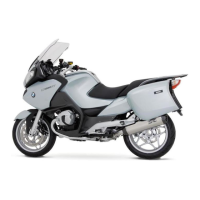How does Integral ABS
work?
The amount of braking force that
can be transferred to the road
depends on factors that include
the coefficient of friction of the
road surface. Loose stones, ice
and snow or a wet road all have
much lower coefficients of friction
than a clean and dry asphalt sur-
face. The lower the coefficient
of friction, the longer the braking
distance.
If the rider increases braking
pressure to the extent that brak-
ing force exceeds the maximum
transferable limit, the wheels start
to lock and the vehicle loses its
directional stability; a fall is im-
minent. Before this situation
can occur, ABS intervenes and
adapts braking pressure to the
maximum transferable braking
force. The wheels continue to
turn and the driving stability is
retained irrespective of the road
condition.
What are the effects of
surface irregularities?
Humps and surface irregular-
ities can cause the wheels to
lose contact temporarily with the
road surface; if this happens the
braking force that can be trans-
mitted to the road can drop to
zero. If the brakes are applied
under these circumstances the
ABS has to reduce braking force
to ensure that directional sta-
bility is maintained when the
wheels regain contact with the
road surface. At this instant the
BMW Motorrad Integral ABS
must assume an extremely low
coefficient of friction, so that the
wheels will continue to rotate un-
der all imaginable circumstances,
because this is the precondition
for ensuring directional stability.
As soon as is registers the ac-
tual circumstances, the system
reacts instantly and adjusts brak-
ing force accordingly to achieve
optimum braking.
What feedback does the
rider receive from the
Integral ABS?
If the ABS has to reduce braking
force on account of the circum-
stances described above, vibra-
tion is perceptible through the
handbrake lever.
When the handbrake lever is
pulled, brake pressure is also
built up at the rear wheel by
the integral function. If the
brake pedal is depressed after
the handbrake lever is pulled,
the brake pressure built up
beforehand is perceptible as
counter-pressure sooner than is
the case when the brake pedal is
depressed either before or at the
same time as the brake lever is
pulled.
6
115
z
Engineering details

